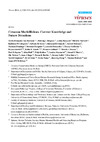Identificador persistente para citar o vincular este elemento:
https://accedacris.ulpgc.es/jspui/handle/10553/47509
| Título: | Cetacean morbillivirus: Current knowledge and future directions | Autores/as: | Van Bressem, Marie Françoise Duignan, Pádraig J. Banyard, Ashley C. Barbieri, Michelle M. Colegrove, Kathleen M. de Guise, Sylvain Di Guardo, Giovanni Dobson, Andrew D. M. Domingo Álvarez, Mariano Fauquier, Deborah A. Fernández Rodríguez, Antonio Jesús Goldstein, Tracey A. Grenfell, Bryan T. Groch, Kátia Regina Gulland, Frances M. D. Jensen, Brenda A. Jepson, Paul D. Hall, Ailsa J. Kuiken, Thijs Mazzariol, Sandro Morris, Sinead E. Nielsen, Ole Raga Esteve, Juan Antonio Rowles, Teresa K. Saliki, Jeremiah T. Sierra Pulpillo, Eva María Stephens, Nahiid Stone, Brett M. Tomo, Ikuko Wang, Jianning Waltzek, Thomas B. Wellehan, James Fx X. |
Clasificación UNESCO: | 242091 Virología animal 310911 Virología 240118 Mamíferos |
Palabras clave: | Bottle-Nosed Dolphins Canine-Distemper-Virus Porpoises Phocoena-Phocoena Polymerase-Chain-Reaction Measles-Virus, et al. |
Fecha de publicación: | 2014 | Publicación seriada: | Viruses | Resumen: | We review the molecular and epidemiological characteristics of cetacean morbillivirus (CeMV) and the diagnosis and pathogenesis of associated disease, with six different strains detected in cetaceans worldwide. CeMV has caused epidemics with high mortality in odontocetes in Europe, the USA and Australia. It represents a distinct species within the Morbillivirus genus. Although most CeMV strains are phylogenetically closely related, recent data indicate that morbilliviruses recovered from Indo-Pacific bottlenose dolphins (Tursiops aduncus), from Western Australia, and a Guiana dolphin (Sotalia guianensis), from Brazil, are divergent. The signaling lymphocyte activation molecule (SLAM) cell receptor for CeMV has been characterized in cetaceans. It shares higher amino acid identity with the ruminant SLAM than with the receptors of carnivores or humans, reflecting the evolutionary history of these mammalian taxa. In Delphinidae, three amino acid substitutions may result in a higher affinity for the virus. Infection is diagnosed by histology, immunohistochemistry, virus isolation, RT-PCR, and serology. Classical CeMV-associated lesions include bronchointerstitial pneumonia, encephalitis, syncytia, and lymphoid depletion associated with immunosuppression. Cetaceans that survive the acute disease may develop fatal secondary infections and chronic encephalitis. Endemically infected, gregarious odontocetes probably serve as reservoirs and vectors. Transmission likely occurs through the inhalation of aerosolized virus but mother to fetus transmission was also reported. | URI: | https://accedacris.ulpgc.es/handle/10553/47509 | ISSN: | 1999-4915 | DOI: | 10.3390/v6125145 | Fuente: | Viruses [ISSN 1999-4915], v. 6 (12), p. 5145-5181 |
| Colección: | Reseña |
Citas SCOPUSTM
204
actualizado el 08-jun-2025
Citas de WEB OF SCIENCETM
Citations
192
actualizado el 08-jun-2025
Visitas
82
actualizado el 24-ago-2024
Descargas
84
actualizado el 24-ago-2024
Google ScholarTM
Verifica
Altmetric
Comparte
Exporta metadatos
Los elementos en ULPGC accedaCRIS están protegidos por derechos de autor con todos los derechos reservados, a menos que se indique lo contrario.
